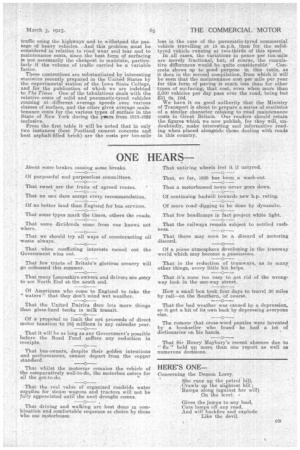Road Surfacino and Vehicle and Highway Costs.
Page 2

Page 3

If you've noticed an error in this article please click here to report it so we can fix it.
MHE CHARGES under the headings of inainten ance and upkeep for a motor vehicle are directly affected by the class of road surface over which the vehicle is run, whilst (what is, perhaps, of more importance) different types of surfacing exert a marked influence on running costs. In a country where the road system, as a whole, is good, the average user does not concern himself with different forma of sur facing, being content merely to classify them at " good," "'bad," or " indifferent," although, if he probes into the problem, he is cerkin to find, among other things, that better adhesion is obtained on some surfaces than on others, that the tendency to skid (other things being equal) varies according to the nature of the surface, and that tyre wear and tear are materially affected by similar influences. That is the aspect of the subject from the point of view of the user, but those authorities concerned with highway maintenance have to face another side of the question. Their immediate concern is to ascertain the suitability of different forms of surfacing to carry the constantly increasing volume of traffic using the highways and to withstand the passage of heavy vehicles. And this problem must be considered in relation to road wear and tear and to maintenance costs, since the best form of surfacing is not necessarily the cheapest to maintain, particularly if the volume of traffic carried be a variable factor.
These contentions are substantiated by interesting statistics recently prepared in the United States by the experimental station of the Iowa State College, and fer the publication of which we are indebted to The Times. One of the tabulations deals with the relative costs of solid and pneumatic-tyred vehicles running at different average speeds over various classes of surface, and the other _gives average maintenance costs for the various types of surface in the State of New York during the years from 1918-1922 inclusive.
From the first table it will be noted that in only two instances (best Portland cement concrete and best asphalt-filled brick) are the costs per ton-mile less in the ease of the pneumatic-tyred commercial vehicle travelling at 75 m.p.h. than for the solidtyred vehicle running at two-thirds of this speed.
In .all cases, the variations in pence per ton-mile are merely fractional, but, of course, the cumulative differences would be quite considerable. Concrete shows up to good purpose in this table, as it does in the second compilation, from which it will be seen that the maintenance cost per mile per year for this form of paving is much less than for other types of surfacing, that cost, even when more than 2,000 vehicles per day pass over the road, being but £31 Os. 10d.
We have it on good authority that the Ministry of Transport is about to prepare a series of statistics of a similar character relating to road maintenance costs in Great Britain. Our readers should retain the figures which we now publish, for they will, undoubtedly, make interesting and informative reading when placed alongside those dealing with roads in this country.




























